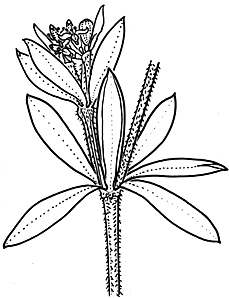Common name: Mountain Woodruff
Asperula gunnii Hook.f. APNI* 
Description: Ascending or decumbent perennial herb; stems to 20 cm long, ± well-branched, ridges conspicuous, ± scabrous with short, recurved hairs, internodes 0.5–3 cm long.
Leaves and stipules in whorls of 5 or 6, rarely 4 at apex, obovate or oblanceolate to elliptic, mostly 4–8 mm long, to 2.5 mm wide, apex mostly acute, midrib narrow, lamina ± glabrous, drying dark green to black.
Flowers in terminal or axillary cymes, 2- or 3-flowered. Corolla white. Male flowers c. 3 mm long; female flowers c. 2 mm long.
Fruit 1–2 mm long, black.
Flowering: summer.
Distribution and occurrence: Occurs in the Ebor and Barrington Tops districts and south from the Blue Mtns. Grows in wooded and grassland areas, usually in damp sites at higher altitudes; often in swamps.
NSW subdivisions: NT, CT, ST
Other Australian states: Vic. Tas. S.A.
Taxon concept of I.R. Thompson (Muelleria 27(1): 36-112, 2009) includes forms that are relatively elongate, with predominantly 4-leaves per whorl and leaves with a relatively high length:width ratio with a narrower pale patch, and sometimes with a sparse stem indumentum. These forms have been recorded from lower latitudes (e.g. Ebor, Barrington Tops, Blue Mtns, Southern Highlands e.g. Wingecarribee Swamp; plants from these more northern N.S.W. localities tend to have leaves with more hairs on the margins and sometimes a minutely acuminate apex) and lower altitudes than the typical alpine or sublalpine forms from Tasmania, the eastern Highlands of Vic., the Brindabella Ranges and the Southern Tablelands of N.S.W. and the A.C.T. The different forms are not considered worthy of taxonomic recognition as they are connected through many intermediates to the typical forms (Thompson 2009).
Text by T.A. James & W.K. Allen (Updated notes by P.G. Kodela, February 2009)
Taxon concept: Flora of NSW 3 (1992)
APNI* Provides a link to the Australian Plant Name Index (hosted by the Australian National Botanic Gardens) for comprehensive bibliographic data
***The AVH map option provides a detailed interactive Australia wide distribution map drawn from collections held by all major Australian herbaria participating in the Australian Virtual Herbarium project.
|


